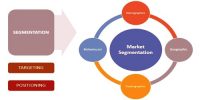The levels of Market Segmentation
To help a company develop more focused marketing plans, each market is broken down into segments. Each level of a market segment requires different information and a different marketing approach. You need to understand what the levels of market segmentation are, how to address them and how they work together to develop comprehensive marketing plans.
- Global
A global market segment is that portion of the population that fits a general demographic profile of your target audience. This is an all-encompassing level of segmentation that contains general information on the specifics of your audience such as age, median income, geographic layout and buying patterns. Marketers divide the target market into different segments on the basis of homogeneous needs, preferences and purchasing power. The global market segment is not compartmentalized or broken down in any way. This is done to identify, capture and retain potential new markets. It is analyzed as a group with its behaviors generalized to fit a marketing profile.
- Niche
Within the global market, the segment is a series of niches: A niche is a group of consumers that have product preferences that group them together. Customers may want or desire a product that is not met completely by the products offered in a market. For example, if you sell sports cars, then you may find that your global target market is males from the ages of 18 to 55. But, within that global segment, you have niches of consumers that preferred cars, cars with leather seats and cars with racing pinstripes. In general, a niche is a segment of the market that has some specific unspecified needs.
- Localized
When you dig deeper into the levels of a market segment, you start to look for where your niches are located. These localized market segments are used to determine where to do specific kinds of marketing and where product needs may be the greatest. Adopting brand and promotion to the wants and needs of local customers like cities, specific stores. It increases manufacturing and marketing cost by reducing economies of scale. This strategy focuses on region-specific marketing to cater to local tastes and preferences. For example, if you find that the majority of the consumers in the red sports car niche mentioned above are located in the southern United States, then your billboards and magazine advertising will feature red sports cars and you will try to stock as many red sports cars in that geographic region as possible.
- Individuals
The final level of market segmentation deals with the consumer habits of individual people. This level is concerned mostly with collecting data from individuals so that you can put them into niches and have data to better understand the overall makeup of your global segment. Through mass communication prevalence individual marketing was locally ignored, but new technologies powerful computers, all have combined to foster mass customization. Salespeople and customer service representatives maintain contact with customers at the individual level to help maintain brand loyalty and preserve repeat business. Most of the B2B selling is an example of individual marketing.
















